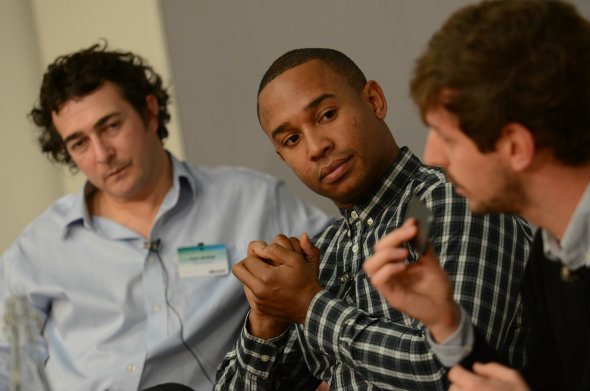Representatives from newsrooms that use short video to engage with readers and viewers told the news:rewired conference, in London today, about there various approaches.
The panel consisted of:
- Kamali Melbourne, online video producer, Channel 4 News
- Peter Winfield, videographics director, the Economist
- Matt Danzico, head of BBC Innovation Lab, BBC
- Michael Downing, chief executive,Tout
Moderated by Andy Dickinson, senior lecturer, School of Journalism and Digital Communication, University of Central Lancashire
Kamali Melbourne said his programme had been making a great push to create short-form video for the web, claiming that “short-form is the future of what we’re trying to do online”.
The team is currently working on “explainers”, short pieces of video content that simplify complex elements of major news stories.
For example, a 1m 30secs video presented by Liam Dutton explained how a polar vortex managed to bring extreme weather conditions to the US and Canada in the early part of 2014.
He said:
For us to move from an hour analysis programme to short-form videos, below two minutes, is quite a change.
Channel 4 is also looking at how they engage with viewers. During the floods, they asked people do short pieces to camera which they posted to Channel 4’s Youtube channel.
He also showed how the programme had recently hired a drone to get some amazing bird’s eye view of the UK floods. Some of the footage went into the report, but it also became an interesting short documentary on the subject of making more interesting video for the web.
He added:
One of the exciting things we’re trying to do is create packages that break the fourth wall.
Though Melbourne was clearly enthused by the future of the medium, he also noted that it was important “not to sacrifice quality for brevity”.
___
Peter Winfield, of The Economist, said that when the paper moved online, charts were simply thrust on in picture form:
We decided what we’d do is make those come to life by animating them and adding voice for analysis and exposition
Videographics of maps and graphs meant they were able to explain more – but engagement was low.
He said:
The aim was to get traditional journalists to make more of what they were writing.
A big move, he said, was to make graphic and videos “fully functional” which means making sure they are available on all devices.
The Economist’s experiments with video length have paid off, as they have recently discovered that one-minute long videos have 95% engagement through to their end.
Matt Danzico, head of BBC’s innovation lab, noted a number of their recent successes in using short, engaging video.
Shortly after Mandela’s death, he said the BBC launched ‘The minute before we knew Mandela had died’ – a video which showed tweets following the news of the announcement to the confirmation of Mandela’s death. There was no correspondent or voiceover. Just text on screen which benefits mobile users.
He said:
It gave a perfect encapsulation of what the world was feeling at that moment.
He also touched on Instafax, a series of brief Instagram videos that the BBC bundles together, which the corporation used to “round up the fragmented audience on the internet”.
This approach to buddling content to suit the audience in this way, he said, came from the realisation that “people on Instagram aren’t the same people who visit the BBC website”, so content had to be changed to suit their requirements.
Michael Dowling, chief executive at Tout, a mobile app used for creating and editing short term video, hit upon one issue that the panel unanimously agreed on.
He said:
Timeliness [with regard to breaking news] trumps production value
Dowling noted that Tout’s success was the result of a simplistic app which even very traditional reporters could use to create “high impact content”.
In the case of breaking news, video can be uploaded in an average time of thirty seconds, “faster than CNN can get a camera crew there”.
Though there is still much debate as to the future of short-form video, all agreed that it was a major and important development in the future on newsrooms.

